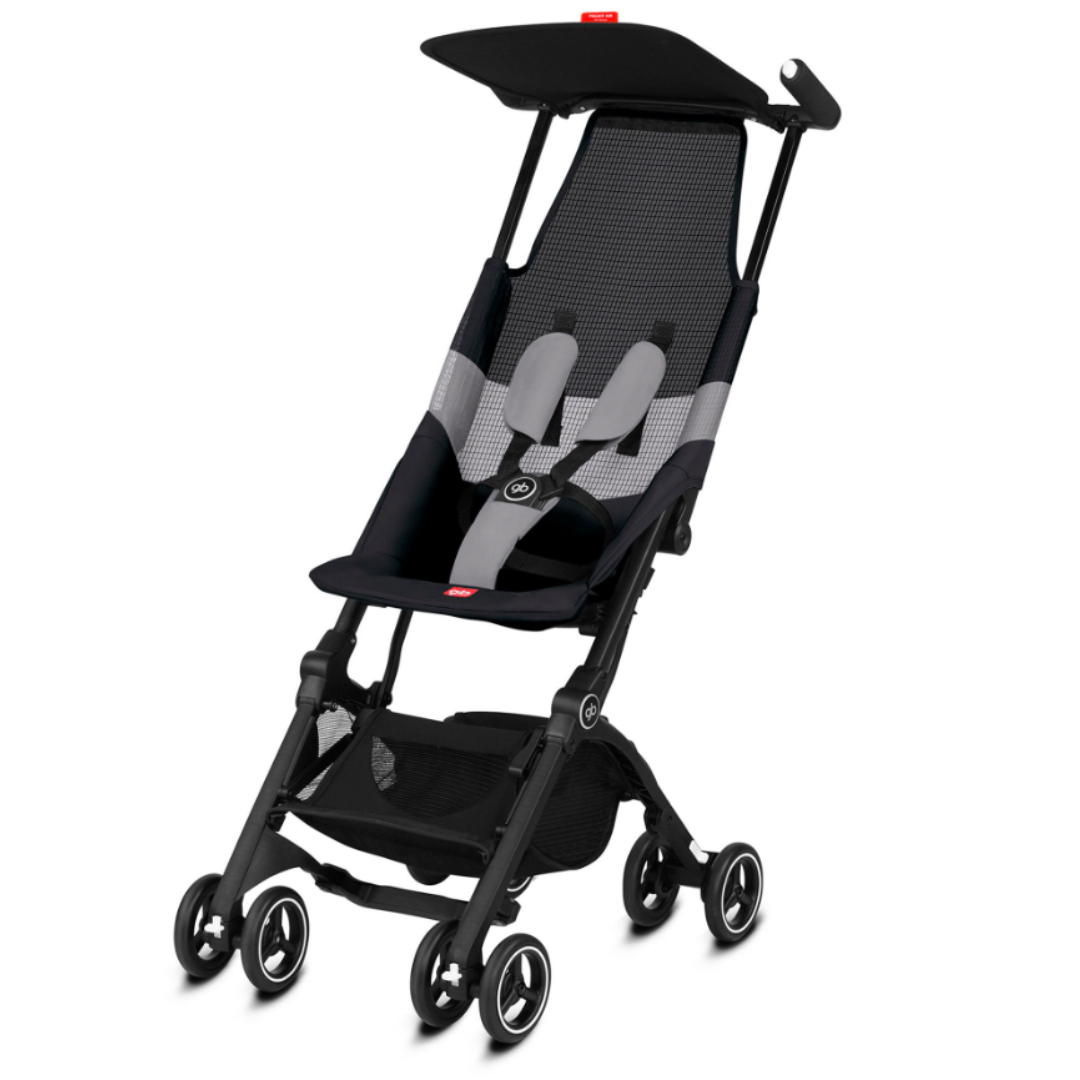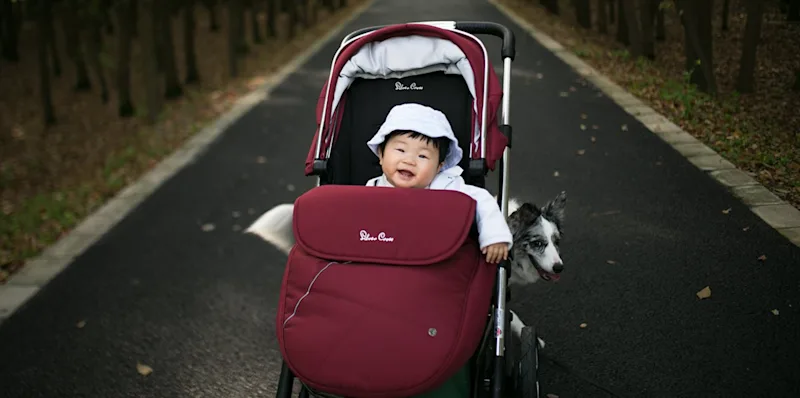This article was updated in August 2022
Can you help with recommendations for a stroller? We are expecting our first child, but plan to have more children. My husband's family is in Canada and we do road trips there often to visit. We live in a condo, so very minimal storage space and we both currently have cars. I am not sure if we should go for a lightweight, compact travel stroller that would fold up easily in our cars and condo or a single to double more bulky stroller that would be good for multiple kids down the road. - Rachel, from the Poppylist Community
Travel system, full-size stroller, stroller and car seat combo, jogging stroller, umbrella stroller … confused? You're not alone. Picking a stroller is a task that seemed simple on its face: figure out which stroller you want to put on your baby registry. But start to research your options, and it’s easy to become frustrated, confused, and worried about wasting a bunch of money. (By and large, strollers are an investment piece when it comes to baby gear.)
When we saw Rachel’s post in our community forum, we knew we needed to write a comprehensive guide to picking the stroller that suits your lifestyle, so you feel empowered to pick the stroller that is going to be best for YOUR family.
Before you narrowed in on an exact stroller style and brand, consider your daily needs and lifestyle. Here are the exact questions to ask and answer before you register for or purchase a stroller, including how to choose a stroller that fits your family.
What kind of stroller do I need?
When shopping for a stroller, the categories you need to be familiar with are travel systems, full-size strollers, jogging strollers, and umbrella strollers. Many families find they want more than one stroller to suit all of the family activities they like to do, and it’s likely that over time your stroller needs will change as your baby grows.
1. Jogging strollers have special features like three wheels; (instead of the typical four); a more advanced suspension system; and large rubber tires, because they’re designed specifically for parents who want to run while pushing their child. Because newborns don’t have sufficient head and neck control, jogging strollers are not recommended for use with babies under 6 months of age. However, some parents decide they’d like their jogging stroller to be their primary full sized stroller, and so you can purchase (or adapt) some jogging strollers as part of a travel system, and use the stroller with an infant car seat until your baby is old enough to sit in the stroller independently. Some models of jogging strollers can pull double and triple duty, by converting into pull-along chariots for cycling or cross-country skiing.

2. A full-size stroller is what comes to mind for most people when you say “stroller.” They are typically loaded with features like cup and phone holders, a basket for toting groceries, toys, or baby essentials, reversible handles or seats, settings that allow your child to sit up or lay down, foot rests, convertible options to stroll with more than one child, and more. They fold to store in a closet or trunk, and they often come bundled with a car seat in a travel system. (We’ll get into more detail about this in a moment.)

3. An umbrella stroller is a lightweight, ultra-basic stroller that’s most commonly used for older babies and toddlers. They are not recommended for use with babies younger than 6 months. They’re narrower and weigh much less than a full size stroller, making them a great choice for families who travel a lot and will be transitioning from car, to plane, to strolling around a city, theme park, or zoo. They also typically have a lower price point than popular full size strollers. Many families wait to make this purchase until their child is a little older, and they have a better idea of their needs in terms of storage space, lifestyle, and budget.

What is a stroller travel system?
At its most basic, a stroller travel system is a full size stroller, compatible infant car seat, and car seat base. The car seat transitions seamlessly between the stroller and base, and the stroller collapses and folds easily, making it easy to take your newborn on the go and safely transition from car to stroller and back again. Some of these systems include a bassinet for newborns as well, or options to add seats for a second and even third child. Many families with more than one car opt to purchase additional bases so every family car has a base.
Most of the popular stroller and car seat manufacturers make adapters, so you can purchase a car seat from one brand, a stroller from another, and kind of “hack” your own system. If you decide this is the right approach for your family, you can contact the manufacturers of the stroller and the car seat to learn what options exist for pairing the products you’re interested in.
The travel system is good for most families who are going to frequently drive and stroll with their babies.
Is a travel system only for newborns?
In a word, no. You will continue to use a travel system with your child up through his toddler years. Once your baby is old enough to sit independently in the stroller, you no longer need to use the system with the car seat attached. However, you’ll still continue to use the stroller for walking outings, and the car seat and the base when driving.
The only element you won’t need for an older baby is the bassinet. Most families stop using it after their babies are a few months old.
We travel a lot. Can you take a stroller on a plane?
Yes! But as checked luggage, not as a carry-on. Unless you’ve purchased a separate ticket for your baby, in most cases the gate agent will have you gate check your car seat and stroller. However, there is no check fee for either.
You can purchase special travel covers for the car seat and stroller, to protect them from wear and tear as they’re loaded into the cargo hold in the plane.
The travel system I’m looking at has an optional bassinet as an add-on. Do I need this? Can’t I just use the car seat?
This question deserves it’s own post, so we collaborated with Anne Hunger of Glüx Kind on a more detailed, thoughtful answer. Click here to read Anne’s post.
What do I need to know about stroller safety?
According to Mayo Clinic, you should consider the following factors when evaluating stroller safety:
- Practical brakes. Look for a stroller that has brakes that are easy to operate. Some strollers have brakes that lock two wheels — a special safety feature. Make sure your baby can't reach the brake release lever.
- A wide base. Strollers that have wide bases are less likely to tip over.
- A single footrest. If you're looking for a side-by-side double stroller, choose one with a single footrest that extends across both sitting areas. Small feet can get trapped between separate footrests.
You should also always take common-sense precautions with baby in the stroller. Don’t leave your child unattended in the stroller; always buckle her in, and watch for little fingers and toes when you’re buckling her in and out of the stroller; always engage the breaks when you step away from the stroller; don’t leave a baby in the stroller in direct sunlight for prolonged periods of time; and stay up-to-date on manufacturer recalls and updates to safety standards.
How do I pick a stroller that's right for me?
Before you narrow in on the brand and model, consider the following four factors:
.png)
1. Lifestyle
- Big city dweller: Do you live in a city, where you commute by foot? Consider the sidewalks you most often travel, the doorways you have to navigate into and out of, and other factors like if your building has an elevator or is a walk-up. How much storage space do you have in your home?
- Smaller city or suburbs: Do you primarily drive to your destination? Will you be most often strolling in planned neighborhoods, developments, or on paved walking trails? Will you walk primarily for exercise and leisure, or for utilitarian purposes? Where will you store the stroller? Do you have to walk up stairs to get into your home? Where do you plan to store the stroller?
2. Preferred activities
- How will you be using the stroller most frequently? For commuting to daycare and then onto the office, or for walks around the neighborhood? What is the condition of the streets and sidewalks where you typically walk? Do you want to eventually run while pushing your child in a stroller? Will you need to pack the stroller into and out of a vehicle on a regular basis? Will you be flying frequently with the stroller?
3. Weight and dimensions
- How heavy is the model you’re considering? Are you able to lift that much weight, carry it up and down stairs if necessary, and load it into and out of the trunk of your car? Is the stroller height comfortable for all of the members of the household who will be strolling with the baby? (If you’re a particularly tall or short person, stroller height can make a big difference in ease of use.) When folded, will the stroller store in the storage space you have available to you? Will it fit into to the trunk of your car?
4. Price
- Strollers can get pricey fast, and often you’re paying for features that are nice-to-have, but not necessary, or styling that looks great, but again, isn’t necessary for function. Think about how much you can afford to budget toward this purchase vs other big ticket items like a crib, high chair. Good options, especially for travel systems, exist at every price point. You can also often find more expensive models and brands by diligently searching on Facebook Marketplace and similar sites.
Once you’ve thought through all of the factors above, you’ll be able to approach your stroller research and eventual purchase with more confidence, knowing that the brand and model you choose will work best for you. Continue browsing our product catalog to pick your stroller, and begin building your Poppylist baby registry today! Click here to create an account.
Photo by: Minnie Zhou


